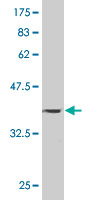ST1714 Sigma-AldrichAnti-PAPPA Mouse mAb (1G3)
This Anti-PAPPA Mouse mAb (1G3) is validated for use in Immunoblotting for the detection of PAPPA.
More>> This Anti-PAPPA Mouse mAb (1G3) is validated for use in Immunoblotting for the detection of PAPPA. Less<<同義語: Anti-Pregnancy-Associated Plasma Protein A, Anti-Pappalysin 1
お勧めの製品
概要
| Replacement Information |
|---|
主要スペック表
| Species Reactivity | Host | Antibody Type |
|---|---|---|
| H | M | Monoclonal Antibody |
価格&在庫状況
| カタログ番号 | 在庫状況 | 包装 | Qty/Pk | 価格 | 数量 | |
|---|---|---|---|---|---|---|
| ST1714-100UGCN |
|
100 μg |
|
— |
| References |
|---|
| Product Information | |
|---|---|
| Form | liquid |
| Formulation | In PBS, pH 7.2. |
| Quality Level | MQ100 |
| Physicochemical Information |
|---|
| Dimensions |
|---|
| Materials Information |
|---|
| Toxicological Information |
|---|
| Safety Information according to GHS |
|---|
| Safety Information |
|---|
| Product Usage Statements |
|---|
| Packaging Information |
|---|
| Transport Information |
|---|
| Supplemental Information |
|---|
| Specifications |
|---|
| Global Trade Item Number | |
|---|---|
| カタログ番号 | GTIN |
| ST1714-100UGCN | 04055977207378 |
Documentation
Anti-PAPPA Mouse mAb (1G3) (M)SDS
| タイトル |
|---|








